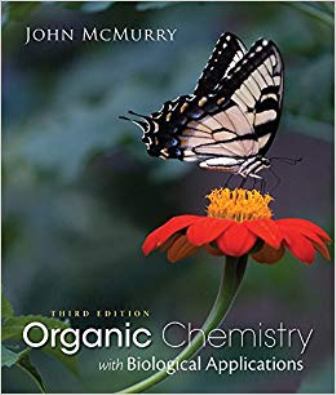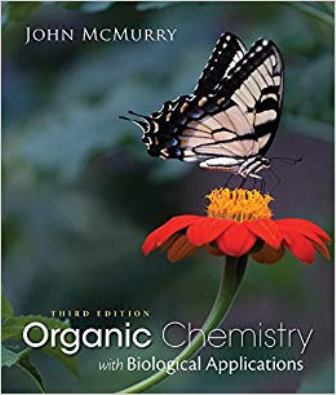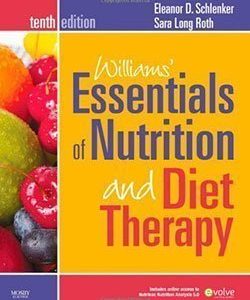This is completed downloadable of Test Bank for Organic Chemistry with Biological Applications, 3rd Edition John E. McMurry

Product Details:
- ISBN-10 : 1305256662
- ISBN-13 : 978-1305256668
- Author: John E. McMurry
Renowned for its student-friendly writing style and fresh perspective, this fully updated Third Edition of John McMurry’s ORGANIC CHEMISTRY WITH BIOLOGICAL APPLICATIONS provides full coverage of the foundations of organic chemistry–enhanced by biological examples throughout. In addition, McMurry discusses the organic chemistry behind biological pathways. New problems, illustrations, and essays have been added. Media integration with OWL for Organic Chemistry, a customizable online learning system and assessment tool, reduces faculty workload, facilitates instruction, and helps students master concepts through tutorials, simulations, and algorithmically-generated homework questions.
Table of Content:
- Ch 1: Structure and Bonding
- 1-1: Atomic Structure: The Nucleus
- 1-2: Atomic Structure: Orbitals
- 1-3: Atomic Structure: Electron Configurations
- 1-4: Development of Chemical Bonding Theory
- 1-5: Describing Chemical Bonds: Valence Bond Theory
- 1-6: sp3 Hybrid Orbitals and the Structure of Methane
- 1-7: sp3 Hybrid Orbitals and the Structure of Ethane
- 1-8: sp2 Hybrid Orbitals and the Structure of Ethylene
- 1-9: sp Hybrid Orbitals and the Structure of Acetylene
- 1-10: Hybridization of Nitrogen, Oxygen, Phosphorus, and Sulfur
- 1-11: Describing Chemical Bonds: Molecular Orbital Theory
- 1-12: Drawing Chemical Structures
- Summary
- Ch 2: Polar Covalent Bonds; Acids and Bases
- 2-1: Polar Covalent Bonds: Electronegativity
- 2-2: Polar Covalent Bonds: Dipole Moments
- 2-3: Formal Charges
- 2-4: Resonance
- 2-5: Rules for Resonance Forms
- 2-6: Drawing Resonance Forms
- 2-7: Acids and Bases: The Bronsted-Lowry Definition
- 2-8: Acid and Base Strength
- 2-9: Predicting Acid-Base Reactions from pKa Values
- 2-10: Organic Acids and Organic Bases
- 2-11: Acids and Bases: The Lewis Definition
- 2-12: Noncovalent Interactions between Molecules
- Summary
- Ch 3: Organic Compounds: Alkanes and Their Stereochemistry
- 3-1: Functional Groups
- 3-2: Alkanes and Alkane Isomers
- 3-3: Alkyl Groups
- 3-4: Naming Alkanes
- 3-5: Properties of Alkanes
- 3-6: Conformations of Ethane
- 3-7: Conformations of Other Alkanes
- Summary
- Ch 4: Organic Compounds: Cycloalkanes and Their Stereochemistry
- 4-1: Naming Cycloalkanes
- 4-2: Cis-Trans Isomerism in Cycloalkanes
- 4-3: Stability of Cycloalkanes: Ring Strain
- 4-4: Conformations of Cycloalkanes
- 4-5: Conformations of Cyclohexane
- 4-6: Axial and Equatorial Bonds in Cyclohexane
- 4-7: Conformations of Monosubstituted Cyclohexanes
- 4-8: Conformations of Disubstituted Cyclohexanes
- 4-9: Conformations of Polycyclic Molecules
- Summary
- Ch 5: Stereochemistry at Tetrahedral Centers
- 5-1: Enantiomers and the Tetrahedral Carbon
- 5-2: The Reason for Handedness in Molecules: Chirality
- 5-3: Optical Activity
- 5-4: Pasteur’s Discovery of Enantiomers
- 5-5: Sequence Rules for Specifying Configuration
- 5-6: Diastereomers
- 5-7: Meso Compounds
- 5-8: Racemic Mixtures and the Resolution of Enantiomers
- 5-9: A Review of Isomerism
- 5-10: Chirality at Nitrogen, Phosphorus, and Sulfur
- 5-11: Prochirality
- 5-12: Chirality in Nature and Chiral Environments
- Summary
- Ch 6: An Overview of Organic Reactions
- 6-1: Kinds of Organic Reactions
- 6-2: How Organic Reactions Occur: Mechanisms
- 6-3: Radical Reactions
- 6-4: Polar Reactions
- 6-5: An Example of a Polar Reaction: Addition of H2O to Ethylene
- 6-6: Using Curved Arrows in Polar Reaction Mechanisms
- 6-7: Describing a Reaction: Equilibria, Rates, and Energy Changes
- 6-8: Describing a Reaction: Bond Dissociation Energies
- 6-9: Describing a Reaction: Energy Diagrams and Transition States
- 6-10: Describing a Reaction: Intermediates
- 6-11: A Comparison between Biological Reactions and Laboratory Reactions
- Summary
- Ch 7: Alkenes and Alkynes
- 7-1: Calculating the Degree of Unsaturation
- 7-2: Naming Alkenes and Alkynes
- 7-3: Cis-Trans Isomerism in Alkenes
- 7-4: Alkene Stereochemistry and the E,Z Designation
- 7-5: Stability of Alkenes
- 7-6: Electrophilic Addition Reactions of Alkenes
- 7-7: Orientation of Electrophilic Addition: Markovnikov’s Rule
- 7-8: Carbocation Structure and Stability
- 7-9: The Hammond Postulate
- 7-10: Evidence for the Mechanism of Electrophilic Additions: Carbocation Rearrangements
- Summary
- Ch 8: Reactions of Alkenes and Alkynes
- 8-1: Preparing Alkenes: A Preview of Elimination Reactions
- 8-2: Halogenation of Alkenes
- 8-3: Halohydrins from Alkenes
- 8-4: Hydration of Alkenes
- 8-5: Reduction of Alkenes: Hydrogenation
- 8-6: Oxidation of Alkenes: Epoxidation
- 8-7: Oxidation of Alkenes: Hydroxylation
- 8-8: Oxidation of Alkenes: Cleavage to Carbonyl Compounds
- 8-9: Addition of Carbenes to Alkenes: Cyclopropane Synthesis
- 8-10: Radical Additions to Alkenes: Chain-Growth Polymers
- 8-11: Biological Additions of Radicals to Alkenes
- 8-12: Conjugated Dienes
- 8-13: Reactions of Conjugated Dienes
- 8-14: The Diels-Alder Cycloaddition Reaction
- 8-15: Reactions of Alkynes
- Summary
- Ch 9: Aromatic Compounds
- 9-1: Naming Aromatic Compounds
- 9-2: Structure and Stability of Benzene
- 9-3: Aromaticity and the Huckel 4n + 2 Rule
- 9-4: Aromatic Ions and Aromatic Heterocycles
- 9-5: Polycyclic Aromatic Compounds
- 9-6: Reactions of Aromatic Compounds: Electrophilic Substitution
- 9-7: Alkylation and Acylation of Aromatic Rings: The Friedel-Crafts Reaction
- 9-8: Substituent Effects in Electrophilic Substitutions
- 9-9: Nucleophilic Aromatic Substitution
- 9-10: Oxidation and Reduction of Aromatic Compounds
- 9-11: An Introduction to Organic Synthesis: Polysubstituted Benzenes
- Summary
- Ch 10: Structure Determination: Mass Spectrometry, Infrared Spectroscopy, and Ultraviolet Spectrosco
- 10-1: Mass Spectrometry of Small Molecules: Magnetic-Sector Instruments
- 10-2: Interpreting Mass Spectra
- 10-3: Mass Spectrometry of Some Common Functional Groups
- 10-4: Mass Spectrometry in Biological Chemistry: Time-of-Flight (TOF) Instruments
- 10-5: Spectroscopy and the Electromagnetic Spectrum
- 10-6: Infrared Spectroscopy
- 10-7: Interpreting Infrared Spectra
- 10-8: Infrared Spectra of Some Common Functional Groups
- 10-9: Ultraviolet Spectroscopy
- 10-10: Interpreting Ultraviolet Spectra: The Effect of Conjugation
- 10-11: Conjugation, Color, and the Chemistry of Vision
- Summary
- Ch 11: Structure Determination: Nuclear Magnetic Resonance Spectroscopy
- 11-1: Nuclear Magnetic Resonance Spectroscopy
- 11-2: The Nature of NMR Absorptions
- 11-3: Chemical Shifts
- 11-4: 13C NMR Spectroscopy: Signal Averaging and FT-NMR
- 11-5: Characteristics of 13C NMR Spectroscopy
- 11-6: DEPT 13C NMR Spectroscopy
- 11-7: Uses of 13C NMR Spectroscopy
- 11-8: 1H NMR Spectroscopy and Proton Equivalence
- 11-9: Chemical Shifts in 1H NMR Spectroscopy
- 11-10: Integration of 1H NMR Absorptions: Proton Counting
- 11-11: Spin-Spin Splitting in 1H NMR Spectra
- 11-12: More Complex Spin-Spin Splitting Patterns
- 11-13: Uses of 1H NMR Spectroscopy
- Summary
- Ch 12: Organohalides: Nucleophilic Substitutions and Eliminations
- 12-1: Names and Structures of Alkyl Halides
- 12-2: Preparing Alkyl Halides from Alkenes: Allylic Bromination
- 12-3: Preparing Alkyl Halides from Alcohols
- 12-4: Reactions of Alkyl Halides: Grignard Reagents
- 12-5: Organometallic Coupling Reactions
- 12-6: Discovery of the Nucleophilic Substitution Reaction
- 12-7: The SN2 Reaction
- 12-8: Characteristics of the SN2 Reaction
- 12-9: The SN1 Reaction
- 12-10: Characteristics of the SN1 Reaction
- 12-11: Biological Substitution Reactions
- 12-12: Elimination Reactions: Zaitsev’s Rule
- 12-13: The E2 Reaction and the Deuterium Isotope Effect
- 12-14: The E1 and E1cB Reactions
- 12-15: Biological Elimination Reactions
- 12-16: A Summary of Reactivity: SN1, SN2, E1, E1cB, and E2
- Summary
- Ch 13: Alcohols, Phenols, and Thiols; Ethers and Sulfides
- 13-1: Naming Alcohols, Phenols, and Thiols
- 13-2: Properties of Alcohols, Phenols, and Thiols
- 13-3: Preparing Alcohols from Carbonyl Compounds
- 13-4: Reactions of Alcohols
- 13-5: Oxidation of Alcohols and Phenols
- 13-6: Protection of Alcohols
- 13-7: Preparation and Reactions of Thiols
- 13-8: Ethers and Sulfides
- 13-9: Preparing Ethers
- 13-10: Reactions of Ethers
- 13-11: Crown Ethers and Ionophores
- 13-12: Preparation and Reactions of Sulfides
- 13-13: Spectroscopy of Alcohols, Phenols, and Ethers
- Summary
- A Preview of Carbonyl Chemistry
- Ch 14: Aldehydes and Ketones: Nucleophilic Addition Reactions
- 14-1: Naming Aldehydes and Ketones
- 14-2: Preparing Aldehydes and Ketones
- 14-3: Oxidation of Aldehydes
- 14-4: Nucleophilic Addition Reactions of Aldehydes and Ketones
- 14-5: Nucleophilic Addition of H2O: Hydration
- 14-6: Nucleophilic Addition of Hydride and Grignard Reagents: Alcohol Formation
- 14-7: Nucleophilic Addition of Amines: Imine and Enamine Formation
- 14-8: Nucleophilic Addition of Alcohols: Acetal Formation
- 14-9: Nucleophilic Addition of Phosphorus Ylides: The Wittig Reaction
- 14-10: Biological Reductions
- 14-11: Conjugate Nucleophilic Addition to a,B-Unsaturated Aldehydes and Ketones
- 14-12: Spectroscopy of Aldehydes and Ketones
- Summary
- Ch 15: Carboxylic Acids and Nitriles
- 15-1: Naming Carboxylic Acids and Nitriles
- 15-2: Structure and Properties of Carboxylic Acids
- 15-3: Biological Acids and the Henderson-Hasselbalch Equation
- 15-4: Substituent Effects on Acidity
- 15-5: Preparing Carboxylic Acids
- 15-6: Reactions of Carboxylic Acids: An Overview
- 15-7: Chemistry of Nitriles
- 15-8: Spectroscopy of Carboxylic Acids and Nitriles
- Summary
- Ch 16: Carboxylic Acid Derivatives: Nucleophilic Acyl Substitution Reactions
- 16-1: Naming Carboxylic Acid Derivatives
- 16-2: Nucleophilic Acyl Substitution Reactions
- 16-3: Reactions of Carboxylic Acids
- 16-4: Reactions of Acid Halides
- 16-5: Reactions of Acid Anhydrides
- 16-6: Reactions of Esters
- 16-7: Reactions of Amides
- 16-8: Reactions of Thioesters and Acyl Phosphates: Biological Carboxylic Acid Derivatives
- 16-9: Polyamides and Polyesters: Step-Growth Polymers
- 16-10: Spectroscopy of Carboxylic Acid Derivatives
- Summary
- Ch 17: Carbonyl Alpha-Substitution and Condensation Reactions
- 17-1: Keto-Enol Tautomerism
- 17-2: Reactivity of Enols: a-Substitution Reactions
- 17-3: Alpha Bromination of Carboxylic Acids
- 17-4: Acidity of a Hydrogen Atoms: Enolate Ion Formation
- 17-5: Alkylation of Enolate Ions
- 17-6: Carbonyl Condensations: The Aldol Reaction
- 17-7: Dehydration of Aldol Products
- 17-8: Intramolecular Aldol Reactions
- 17-9: The Claisen Condensation Reaction
- 17-10: Intramolecular Claisen Condensations: The Dieckmann Cyclization
- 17-11: Conjugate Carbonyl Additions: The Michael Reaction
- 17-12: Carbonyl Condensations with Enamines: The Stork Reaction
- 17-13: Biological Carbonyl Condensation Reactions
- Summary
- Ch 18: Amines and Heterocycles
- 18-1: Naming Amines
- 18-2: Properties of Amines
- 18-3: Basicity of Amines
- 18-4: Basicity of Arylamines
- 18-5: Biological Amines and the Henderson-Hasselbalch Equation
- 18-6: Synthesis of Amines
- 18-7: Reactions of Amines
- 18-8: Heterocyclic Amines
- 18-9: Fused-Ring Heterocycles
- 18-10: Spectroscopy of Amines
- Summary
- Ch 19: Biomolecules: Amino Acids, Peptides, and Proteins
- 19-1: Structures of Amino Acids
- 19-2: Amino Acids and the Henderson-Hasselbalch Equation: Isoelectric Points
- 19-3: Synthesis of Amino Acids
- 19-4: Peptides and Proteins
- 19-5: Amino Acid Analysis of Peptides
- 19-6: Peptide Sequencing: The Edman Degradation
- 19-7: Peptide Synthesis
- 19-8: Protein Structure
- 19-9: Enzymes and Coenzymes
- 19-10: How Do Enzymes Work? Citrate Synthase
- Summary
- Ch 20: Amino Acid Metabolism
- 20-1: An Overview of Metabolism and Biochemical Energy
- 20-2: Catabolism of Amino Acids: Deamination
- 20-3: The Urea Cycle
- 20-4: Catabolism of Amino Acids: The Carbon Chains
- 20-5: Biosynthesis of Amino Acids
- Summary
- Ch 21: Biomolecules: Carbohydrates
- 21-1: Classifying Carbohydrates
- 21-2: Representing Carbohydrate Stereochemistry: Fischer Projections
- 21-3: D,L Sugars
- 21-4: Configurations of the Aldoses
- 21-5: Cyclic Structures of Monosaccharides: Anomers
- 21-6: Reactions of Monosaccharides
- 21-7: The Eight Essential Monosaccharides
- 21-8: Disaccharides
- 21-9: Polysaccharides and Their Synthesis
- 21-10: Some Other Important Carbohydrates
- Summary
- Ch 22: Carbohydrate Metabolism
- 22-1: Hydrolysis of Complex Carbohydrates
- 22-2: Catabolism of Glucose: Glycolysis
- 22-3: Conversion of Pyruvate to Acetyl CoA
- 22-4: The Citric Acid Cycle
- 22-5: Biosynthesis of Glucose: Gluconeogenesis
- Summary
- Ch 23: Biomolecules: Lipids and Their Metabolism
- 23-1: Waxes, Fats, and Oils
- 23-2: Soap
- 23-3: Phospholipids
- 23-4: Catabolism of Triacylglycerols: The Fate of Glycerol
- 23-5: Catabolism of Triacylglycerols: B-Oxidation
- 23-6: Biosynthesis of Fatty Acids
- 23-7: Prostaglandins and Other Eicosanoids
- 23-8: Terpenoids
- 23-9: Steroids
- 23-10: Biosynthesis of Steroids
- 23-11: Some Final Comments on Metabolism
- Summary
- Ch 24: Biomolecules: Nucleic Acids and Their Metabolism
- 24-1: Nucleotides and Nucleic Acids
- 24-2: Base Pairing in DNA: The Watson-Crick Model
- 24-3: Replication of DNA
- 24-4: Transcription of DNA
- 24-5: Translation of RNA: Protein Biosynthesis
- 24-6: DNA Sequencing
- 24-7: DNA Synthesis
- 24-8: The Polymerase Chain Reaction
- 24-9: Catabolism of Nucleotides
- 24-10: Biosynthesis of Nucleotides
- Summary
- Ch e25: Secondary Metabolites: An Introduction to Natural Products Chemistry
- 25-1: Classifying Natural Products
- 25-2: Biosynthesis of Pyridoxal Phosphate
- 25-3: Biosynthesis of Morphine
- 25-4: Biosynthesis of Erythromycin
- Summary
- Ch e26: Orbitals and Organic Chemistry: Pericyclic Reactions
- 26-1: Molecular Orbitals of Conjugated Pi Systems
- 26-2: Electrocyclic Reactions
- 26-3: Stereochemistry of Thermal Electrocyclic Reactions
- 26-4: Photochemical Electrocyclic Reactions
- 26-5: Cycloaddition Reactions
- 26-6: Stereochemistry of Cycloadditions
- 26-7: Sigmatropic Rearrangements
- 26-8: Some Examples of Sigmatropic Rearrangements
- 26-9: A Summary of Rules for Pericyclic Reactions
- Summary
- Ch e27: Synthetic Polymers
- 27-1: Chain-Growth Polymers
- 27-2: Stereochemistry of Polymerization: Ziegler-Natta Catalysts
- 27-3: Copolymers
- 27-4: Step-Growth Polymers
- 27-5: Olefin Metathesis Polymerization
- 27-6: Polymer Structure and Physical Properties
- Summary
- Appendix A: Nomenclature of Polyfunctional Organic Compounds
- Appendix B: Acidity Constants for Some Organic Compounds
- Appendix C: Glossary
- Appendix D: Answers to In-Text Problems
- Index





